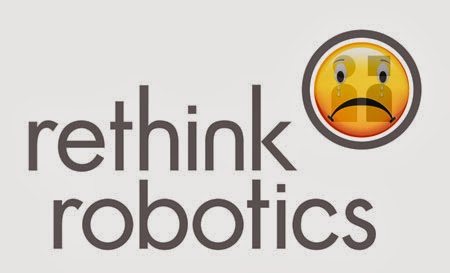
Robohub.org
Rethink Robotics is downsizing

A sad day at Rethink Robotics. 21 jobs have been cut in Rethink’s first layoff.
Although Rethink Robotics is downsizing, their action is not indicative of the robotics industry, which is booming and hiring.
The Boston Globe reported that Rethink Robotics, maker of the $22,000 Baxter 2-armed robot, has cut 21 jobs from their staff of approximately 90.
In the Boston Globe article Rethink CEO Scott Eckert said:
The layoffs are the result of Rethink deciding to focus on the market segments that have been most receptive to Baxter since its launch: plastics manufacturing, consumer goods packaging, warehousing and logistics. Our volume trends are encouraging, our customer pipeline is encouraging, and we expect to see significant growth in 2014, however we will be able to achieve that in a more focused manner with fewer resources.
Since 2005, Rethink Robotics (previously named Heartland Robotics) has taken in $73.5 million from Boston-based VCs and Bezos Expeditions (the personal investment fund of Jeff Bezos), the most recent $11.5 million in November, 2013 (source: CrunchBase).

Rethink Robotics’ Rodney Brooks.
Rethink Chairman and Chief Technology Officer Rodney Brooks has been an energetic and eloquent spokesman for building and selling an affordable, safe and easy to train plug and play robot to help US manufacturers — particularly smaller shops and factories. With such a robot, Brooks assured, these businesses could increase productivity and keep jobs from migrating offshore. The two-armed Baxter robot is his vision. Thus it comes as a big surprise that Rethink needs to retrench their operations and cut 23+% of their staff to focus on the few industry sectors in which they have deployed robots.
Brooks has been right on the mark in describing the needs of small and medium-sized manufacturers. He’s defined the marketplace, defined their needs, and gotten people to accept that an easy-to-train robot can help improve productivity, be safe to work alongside and have affordable metrics. He’s even built and funded a company that ramped up to be able to produce 1,000 of these robots a year. But the robot itself doesn’t measure up to those needs at present. It’s been a work in progress — a miraculous achievement but one not fully ready for factory operations. Perhaps this highly publicized ramping up has clouded the focus on improving the product to live up to their promise (and the sizzle that Brooks has been selling).
Baxter’s main competitor has many of the same positive characteristics as Baxter: relatively low cost, it’s safe to work alongside humans, it’s plug and play, and training is relatively easy. Universal Robot’s UR line of robots cost a bit more and only have one arm. However, they work much faster, with more precision, can carry a heavier load and are engineered to have a longer work life.
Universal Robots has sold 2,500+ robots in 50+ countries through more than 200 distributors in the last five years. The Danish robot manufacturer added 50 people in 2013, a 100% increase in the company staff currently totaling 97 worldwide, and is hiring for 2014. They are ramping up to move into larger facilities with a much greater manufacturing capability.
Ed Mullen, the company’s National Sales Manager in North America attributes the growth of Universal Robots to the quality and capability of the robots the company has been able to create. “They meet the expectations of SMEs: a collaborative, user-friendly robot presenting a plug&play automation solution for a wide range of industries. Not only have we been able to penetrate large accounts — supplying the first collaborative robots to BMW and VW — we’ve also been able to get our robots on the shop floors of many small and medium sized businesses that never thought they’d be able to employ a robot due to cost and complexity.”
With financial news reporting big robotic acquisitions by Stryker ($1.5 billion for MAKO Surgical Robotics), Apple ($350 million for PrimeSense) and Google which has set up a robotics division and seeded it with seven start-ups and an eighth acquisition announced today – Boston Dynamics (of Big Dog, Cheetah and ATLAS fame) – it seems clear that the layoff at Rethink is not indicative of the robotics industry in general. In fact, there’s a hiring boom searching for robotics talent country-wide.
How can it be that such a prominent headliner as Rethink Robotics is regrouping? Four likely answers: (1) they were trying to do too much with too many people; (2) they were rushed to market by their VC investors; (3) they provided a product (the Baxter robot) that offered too much but didn’t do it too well; and (4) they haven’t yet finished the development of their product so that it delivers what the buyers want and need: a fast, safe, flexible, cheap and easy-to-train co-robot.
tags: Baxter, Rethink Robotics, Rodney Brooks, Universal Robots


